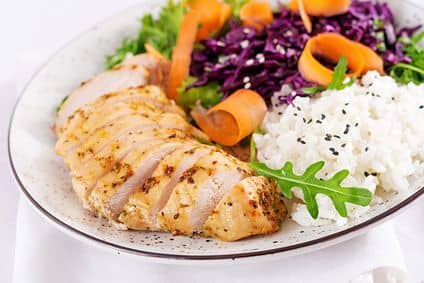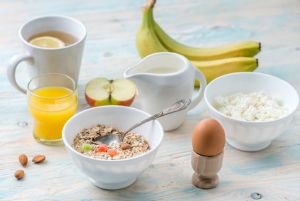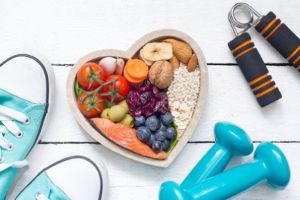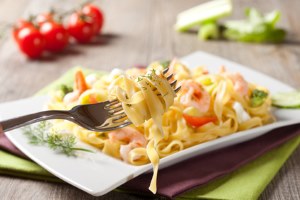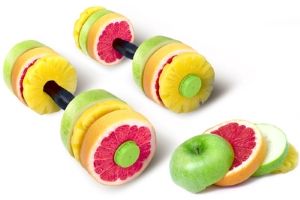Determine your objective!
Creating a tailor-made food program expresses a clear desire to take charge of one's own life. We congratulate you on this! As you will have noticed, there are 1001 food plans on the Internet but it is difficult to appropriate it according to your tastes, constraints and objectives. Today, we will explain to you how to easily develop your own food program just like I regularly do as a sports coach for my clients.
The first step is simple but important because it is about determining YOUR objective! The latter is yours. It can be a desire to lose weight, gain muscle, draw, improve performance, health, etc. To help you, read our article how to define a SMART objective.
So what is YOUR objective?
What foods to choose
Once the objective is in mind, it's time to make your shopping list! The basic principle is to avoid industrial foods as much as possible. In this category, we can find sodas, cookies, sweets, pizzas, sauces, ready meals or fast food. These foods have undergone many unhealthy transformations, making them too fatty, too sweet and/or full of additives.
Don't worry, there are a lot of healthy foods for your health, allowing you to prepare a balanced meal. From this list of foods and beverages, you can create recipes from the simplest to the most complex according to your inspiration and talent.
| Breakfast | Snacks | Meals |
|---|---|---|
| Vegetable drink | Eggs | White meat |
| Oat flakes | Turkey breast | Fish |
| Eggs | Chicken breast | Crustacean |
| Oilseeds | Almonds | Rice |
| Fruits | Cashew nuts | Pasta products |
| Coconut oil | Oat flakes | Vegetables |
| Cottage cheese | Muesli | Olive oil |
| Oat bran | Cottage cheese | Walnut oil |
| Tea / Coffee | Fruits | Fruits |
| Lemon water | Honey | Cottage cheese |
Frequency of meals
Whether you want to take muscle or lose fat, the idea is to split your meals. In concrete terms, it is a matter of making your 3 usual meals (morning, noon and evening) to which you add 2 snacks, one in the morning and another in the middle of the afternoon. This operation has two major interests:
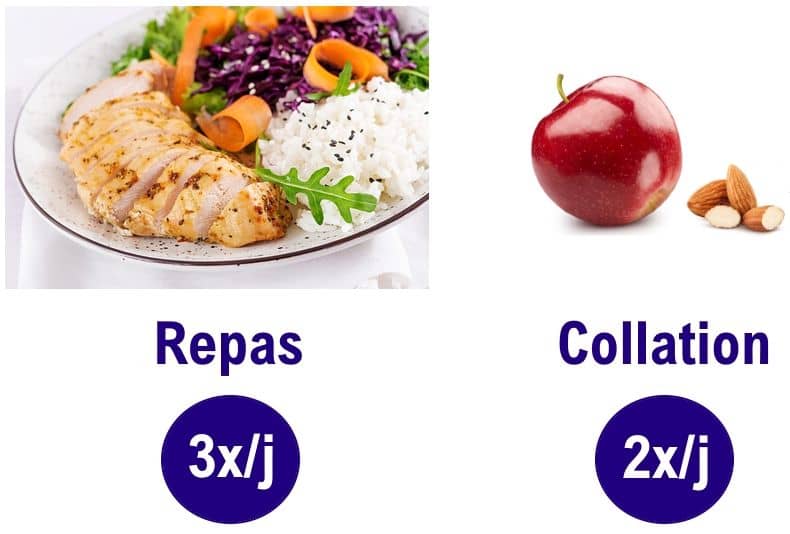
- You are no longer hungry between meals, thus avoiding the craving and snacking.
- You improve food assimilation and the quality of your digestion by reducing the quantities at each food intake.
The snack can look like a fruit, a few oilseeds and a slice of turkey breast. Quick and easy to set up, this harmless little gesture will help you reach your goal faster.
For people who want to gain weight and muscle mass, snacking improves protein assimilation while easily increasing their daily calorie ratio.
If you want to lose weight, the snack avoids arriving hungry at the next meal, which often involves excessive storage or a craving for a snack.
A 3rdsnack can be taken just before bedtime. Usually, it is a bowl of cottage cheese with/without accompaniment (dark chocolate, honey or cereal). This last food intake of the day is useful for people who are hungry with falling asleep or want to add a protein snack before bedtime.
Macronutrient distribution
A correct distribution of macronutrients is essential to create a quality food plan. Understand that not all calories are equal. In practice, 2000 kcal per day through fast food and 2000 kcal per day from quality fruit, vegetables and food will not have the same impact on your body shape, fitness and health. It is therefore important to monitor your calories and the distribution of macronutrients.
A typical individual needs to:
- 1 g of fat per kg/body weight
- 1.5 g of protein per kg/body weight (2 g if it is intended to build muscle mass)
- The rest in carbohydrates which serve as a caloric adjustment
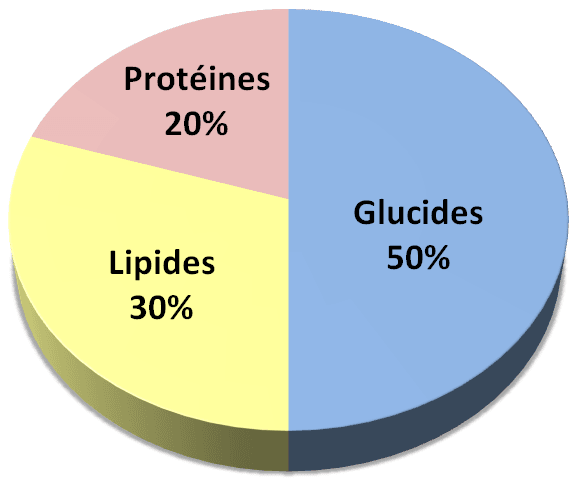
For example, Marc weighs 70 kg and must consume 2000 kcal to maintain his weight. For information, 1 g of fat is approximately 9 kcal while 1 g of protein or carbohydrate is 4 kcal. When developing his menus, he will need to:
- 70 x 1 =70 g fat per day (about 630 kcal)
- 70 x 1.5 = 105 g protein (420 kcal)
This represents about 1050 kcal. Carbohydrates will supplement up to 950 kcal, which represents 237 g through rice, pasta, sweet potatoes, etc.
To return to our previous comments, 2000 kcal from hamburgers, french fries and sodas will inevitably create macronutrient imbalances. This will make it difficult for you to meet both your calorie and macronutrient needs. Through a healthy and balanced diet, all lights will be green.
Concrete example of creating a 100% personalized food program
After an essential theoretical reminder, you will learn how to create your own program in only 3 steps.
Step 1: the number of calories
The first step is to know your calorie needs. This is useful for managing the amount of food to eat. We will use the formula of Harris and Benedict (1919) to calculate base metabolism. We also offer you below a tool to calculate it in 1 click.
- Male = (13.7516 x Weight (kg)) + (500.33 x Height (m)) - (6.7550 x Age) + 66.473
- Female = (9.5634 x Weight (kg)) + (184.96 x Height (m)) - (4.6756 x Age) + 655.0955
Depending on your level of activity, multiply this number by:
- x 1,375 if you have an office job and a low sports expenditure (sedentary)
- x 1.56 if you train 1 to 3 times a week (light physical activity)
- x 1.64 if you train 4 to 6 times a week (moderate physical activity)
- x 1.82 if you train more than 6 times a week (intense physical activity)
If you want to keep your weight stable : The number obtained corresponds to your maintenance. By consuming this number of calories, you should not gain or lose weight.
To gain weight : You can add +10% to your diet and then gradually increase with the results.
For weight loss : You can remove -10% in your daily calorie requirement calculation by gradually reducing carbohydrates.
For example, Sophie, 35 years old, 1 m 80 for 70 kg wants to lose weight. Being mainly sedentary, its base metabolism is 1494 kcal. This represents the number of calories his body needs to function properly. When we add her sedentary activity (x1,375), we realize that she must consume 2054 kcal daily to maintain her stable weight.
If Sophie's goal is to lose weight, she will have to reduce calories by 10% and then continue to do so until she reaches her goal. Thus, during the first few weeks, it aims for a total caloric value of 1848 kcal.
Step 2: the number of meals
As we have seen, splitting meals is important. Thus, to avoid cravings and optimize your chances, you should schedule 3 meals + 2 snacks. Snacks should be balanced in carbohydrates, fats, proteins. Thus, a fruit, a few almonds and a slice of chicken breast will do at 10am and 4pm.
Step 3: Protein / Fat / Carbohydrate distribution
Sophie weighs 70 kg. Thus, she will need 70 g of fat in her day as well as 105 g of protein. Once the macronutrients are properly distributed, she can take care of the carbohydrate distribution. To make your task easier and create your program in less than 10 minutes, sites like myfitnesspal will be useful to you.
My balanced menu
Here is an example of a balanced menu:
Breakfast: 446 kcal / 46 g carbohydrates / 21 g fat / 23 g protein :
1 glass of lemon water
1 vegetable drink
30 g oatmeal2
eggs
1 banana
Snack 10h:
1 fruit
2 slices of chicken breast
1 handful of cashew nuts
Lunch: 435 kcal / 48 g carbohydrates / 12 g fat / 24 g protein :
100 g fish
100 g vegetables
70 g pasta
A spoonful of olive oil
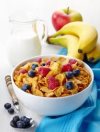 Pour stocker du glycogène plutôt que du gras, consommez des glucides de faible index glycémique
Pour stocker du glycogène plutôt que du gras, consommez des glucides de faible index glycémique
Privilégiez les glucides de faible index glycémique ! pour refaire le plein de réserves : lentilles, céréales complètes, riz basmati, pain complet, fruits et légumes. Accompagnez vos glucides de produits riches en fibres (salade, légume, potage en entrée) pour diminuer l'IG. Vous favoriserez le stockage sous forme de glycogène plutôt que de graisses !
Snack 4 pm
2 fruits150 g cottage cheese
Some almonds
Dinner: 460 kcal / 39 g carbohydrates / 18 g fat / 25 g protein :
100 g chicken
200 g vegetables50 g rice
A drizzle of olive oil
Totals: 1850 kcal / 190 g carbohydrates / 70 g fat / 105 g protein
In conclusion
With a few basic nutritional skills, it's easy to create your own 100% personalized food program. Once you have mastered the basics, you too can create your food plan in 3 steps. Whether you want to lose weight, gain muscle or maintain a stable weight, the main principles remain the same. The difference is mainly in terms of calories and carbohydrate distribution.
These articles may also interest you
10 key foods to improve your athletic performance
Alimentation du sportif : quels glucides consommer quand on fait du sport ?
Alimentation et sport : les vitamines indispensables au sportif
Sport et alimentation végétarienne : est-ce compatible ?
Alimentation du sportif : l'équilibre alimentaire global
Photo credit : Fotolia.com

